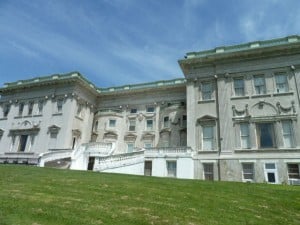Not long after she married financier and philanthropist Ogden Mills in 1882, Ruth Livingston inherited her childhood home in Staatsburg, New York. With views of the Catskill Mountains, the house at Staatsburg perches over sweeping lawns that stop just short of the Hudson River.
 The Livingston family had been prominent landowners in the Hudson Valley since the seventeenth century–this property had once belonged to Ruth’s great grandfather, Morgan Lewis, the third governor of New York State. Once they became Staatsburg’s owners, the Mills commissioned the prominent New York City architects, McKim, Mead and White to remodel and enlarge the 25-room Greek Revival house.
The Livingston family had been prominent landowners in the Hudson Valley since the seventeenth century–this property had once belonged to Ruth’s great grandfather, Morgan Lewis, the third governor of New York State. Once they became Staatsburg’s owners, the Mills commissioned the prominent New York City architects, McKim, Mead and White to remodel and enlarge the 25-room Greek Revival house.
By 1896, it had been transformed into a Beaux-Arts mansion of 65 rooms and 14 bathrooms. Skillfully combined with new 17th and 18th century French interior decoration, original elements of the earlier home were left intact, including all trim, molding and many original fireplaces. This merging was characteristic of the American Renaissance style. Since the Mills family owned five residences, they occupied their Staatsburg home mainly in the fall, and often entertained up to eighty guests at a time.
As was the custom at many Hudson Valley country places of the period, greenhouses on the property supplied cut flowers and fruits for the residence. Sketches dating to 1895 show greenhouses proposed by the relatively new company, Lord & Burnham—recently relocated from Buffalo to Irvington, New York, just down the Hudson River.
Recent improvements in glass manufacture had resulted in the availability of large panes of glass –greatly increasing light efficiency inside greenhouses. At the same time, greenhouse structure had evolved; frames once constructed of heavy wood had been changed to lighter wood, and then to steel, eliminating cumbersome light-obstructing structural elements.
The greenhouses at this property were built by Lord & Burnham between 1895 and 1910 and consisted of steel frames with large glass panes. Sadly, nothing remains of them today.
The greenhouse range at Staatsburg included a potting house and office, houses for orchids and geraniums, stocks, snapdragons, peas, a rose house, two houses for violets, a tree house, another for ferns and geraniums, one for carnations, and yet another just for geraniums. An article in Town & Country Magazine from May 3, 1902 states that “If a visitor were to ask Mr. Ogden Mills in what phase of his country life he found the most enjoyment, the visitor would be escorted to a greenhouse.”
Article copyright by Alice McGowan written for http://www.hartley-greenhouses.com










